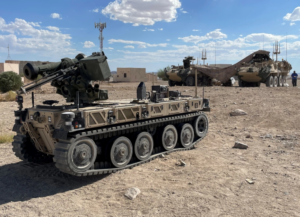The Army has partnered with DoD’s Defense Innovation Unit (DIU) and selected eight firms to work on prototyping autonomous software and processes for the Robotic Combat Vehicle (RCV) program, to include Anduril Industries and Palantir Technologies
[PLTR] working on software architecture development.
The remaining companies tapped for the Ground Vehicle Autonomous Pathways (GVAP) project include Forterra, Kodiak Robotics, Neya Systems and Overland AI as autonomous navigation vendors and Applied Intuition Inc. and Scale AI working on the “machine learning and autonomy pipeline.”

“Together, these companies will support the Army’s Robotic Combat Vehicle program in developing a robust, capable and compliant software system that can operate in a variety of autonomous modes and rapidly integrate a variety of payloads as they become available,” DIU said in its announcement on Wednesday.
The Army’s RCV program is currently in an initial competitive prototyping phase, having selected Textron Systems [TXT], General Dynamics Land Systems [GD], Oshkosh Defense [OSK] and McQ Inc. this past fall to each deliver two test platforms by August 2024 (Defense Daily, Sept. 21).
Those four firms were awarded a combined total of $24.7 million for phase one of the RCV program, with the Army planning to ultimately select one company in fiscal year 2025 to deliver nine prototypes before making a production decision in FY ‘27.
DIU said the GVAP project will work on prototyping software to support RCV navigation abilities as well as providing a “technical pipeline to continue rapid modeling, testing, evaluation, development and deployment of autonomous features as they become commercially-available.”
The Army and DIU received 110 total responses across two GVAP solicitations, according to Wednesday’s announcement, before downselecting to the eight vendors.
“We are excited to work with these best-in-class autonomy providers, software experts and systems integrators as we drive towards merging software capabilities developed through the RCV Software Acquisition Pathway into the RCV Full System Prototype,” Steve Herrick, the Army’s RCV product manager, said in a statement. “Our software system integrators will also be the first to implement Traceability, Observability, Replaceability, and automated Consumption compliance for Army software-centric ground vehicles, thereby helping the Army ensure programmatic flexibility and performance over time.”
Anduril on Wednesday said its work on GVAP will include producing a “prototype architecture and framework that will enable RCV variants to autonomously navigate varied terrain, seamlessly transition between multiple third-party and government-owned autonomous mobility stacks and allow for autonomous or remote management of vehicle payloads, sensors, and effectors.”
“Integrating disparate hardware and software is a critical step in the development and validation of any autonomous system. As the Army evaluates potential payloads, software modules, and autonomy stacks for the RCV program, developing a robust and flexible integration framework will prove critical to the program’s success,” Zach Mears, Anduril’s senior vice president of strategy, said in a statement. “We are excited to bring our deep hardware-software integration expertise to one of the Army’s leading ground autonomy programs, and look forward to demonstrating how we can streamline and accelerate development, evaluation, integration, and deployment of these critical capabilities.”
Palantir added on Wednesday that its work on GVAP in support of RCV will include prototyping “the integration of disparate hardware and software technologies, including safety-critical software.”
“We’re proud to deliver next-generation, interoperable solutions to the Army’s first program leveraging a software integrator,” Palantir said in a statement.